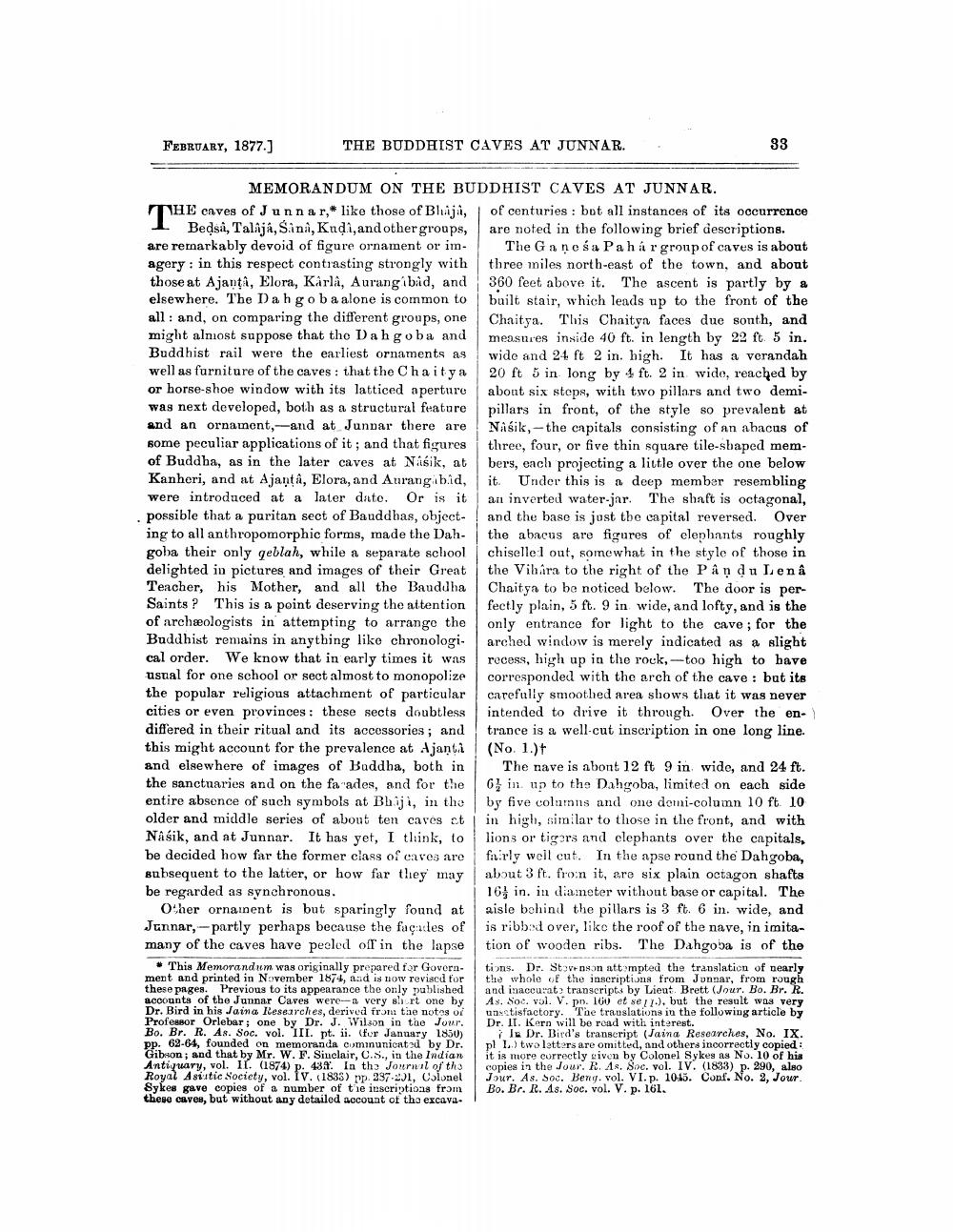________________
FEBRUARY, 1877.]
THE BUDDHIST CAVES AT JUNNAR.
MEMORANDUM ON THE BUDDHIST CAVES AT JUNNAR. THE caves of Junnar,* like those of Bhiji, of centuries: bot all instances of its occurrence
1 Bedsa, Talaja, Sina, Kudi, and other groups, are noted in the following brief descriptions. are remarkably devoid of figure ornament or im- The Ganosa Pahá r group of caves is about agery: in this respect contrasting strongly with three miles north-east of the town, and about those at Ajanta, Elora, Karla, Aurangibad, and 360 feet above it. The ascent is partly by a elsewhere. The Dah go ba alone is common to built stair, which leads up to the front of the all: and, on comparing the different groups, one Chaitya. This Chaityn faces due sonth, and might alnost suppose that the Dah goba and measures inside 40 ft. in length by 22 ft 5 in. Buddhist rail were the earliest ornaments as wide and 24 ft 2 in. high. It has a verandah well as furniture of the caves : that the Chaitya 20 ft 5 in long by 4 ft. 2 in wide, reached by or horse-shoe window with its latticed aperturo about six steps, with two pillars and two demiwas next developed, both as a structural feature pillars in front, of the style so prevalent at and an ornament,--and at Junnar there are Nasik,--the capitals consisting of an abacus of some peculiar applications of it; and that figures three, four, or five thin square tile-sbaped memof Buddha, as in the later caves at Nasik, at bers, each projecting a little over the one below Kanheri, and at Ajanta, Elora, and Aurangibid, it. Under this is a deep member resembling were introduced at a later dato. Or is it! an inverted water-jar. The shaft is octagonal, possible that a puritan sect of Bauddhas, object- ! and the base is just the capital reversed. Over ing to all anthropomorphic forms, made the Dah- the abacus are figures of elephants roughly goba their only qeblah, while a separate school chisellel out, somewhat in the style of those in delighted in pictures and images of their Great the Vibira to the right of the Pân du Lenâ Teacher, his Mother, and all the Bauddha Chaityn to be noticed below. The door is perSaints? This is a point deserving the attention fectly plain, 5 ft. 9 in wide, and lofty, and is the of archæologists in attempting to arrange the only entrance for light to the cave; for the Buddhist remains in anything like chronologi. arched window is merely indicated as a slight cal order. We know that in early times it was rocess, high up in the rock, -too high to have usual for one school or sect almost to monopolize corresponded with the arch of the cave : but its the popular religious attachment of particular carefully smoothed area shows that it was never cities or even provinces: these sects doubtless intended to drive it through. Over the endiffered in their ritual and its accossories; and trance is a well-cut inscription in one long line. this might account for the prevalence at Ajanta (No. 1.) and elsewhere of images of Buddha, both in The nave is abont 12 ft 9 in wide, and 24 ft. the sanctuaries and on the fa ades, and for the 6) in up to the Dahgoba, limited on each side entire absence of such symbols at Bhij, in the by five columns and one domi-column 10 ft 10 older and middle series of about ten caves et in high, similar to those in the front, and with Nasik, and at Junnar. It has yet, I think, to lions or tigers and elephants over the capitals, be decided how far the former class of caves are fairly weil cut. In the apse round the Dahgoba, subsequent to the latter, or how far they may about 3 ft. froin it, are six plain octagon shafts be regarded as synchronous.
16 in. in diameter without base or capital. The Other ornainent is but sparingly found at aisle behind the pillars is 3 ft. 6 in. wide, and Junnar,-partly perhaps because the facades of is ribbad over, like the roof of the nave, in imita
any of the caves have peeled off in the lapsetion of wooden ribs. The Dahgoba is of the # This Memorandum was originally prepared for Govern- tions. Dr. Stevenson attempted the translation of nearly ment and printed in November 1874, and is now revised for the whole of the inscriptions from Junnar, from rough these pages. Previous to its appearance the only published and inaccurate transcripts by Lieat. Brett (Jour. Bo. Br. R. accounts of the Junnar Caves were very short one by As, Soc. vol. V. pn. 100 et se .), but the result was very Dr. Bird in his Jaina Researches, derived from the notos oi uoxetisfactory. Tie translations in the following article by Professor Orlebar; one by Dr. J. Wilson in the Jour. Dr. II. Kern will be read with interest. Bo. Br. R. As. Soc. vol. III. pt. ii. (for January 1850) i la Dr. Bird's transcript (Jaina Researches, No. IX. pp. 62-64, founded on memoranda cuminunicated by Dr. pl L.) two letters are omitted, and others incorrectly copied : Gibson; and that by Mr. W.F. Sinclair, C.S., in the Indian it is more correctly given by Colonel Sykes as No. 10 of his Antiquary, vol. II. (1874) p. 434. In the Journal of th> copies in the Jour. R. A. Soc. vol. IV. (1833) p. 290, also Royal Asiatic Society, vol. IV. (1833) typ 337.901, Colonel Jour. As. Soc. Beng. vol. VI. p. 10:15. Conf. No. 2, Jour. Sykes gave copies of a number of the inscriptions from Bo. Br. R. 18. Soc. vol. V. p. 161. these caves, but without any detailed account of the excava.




